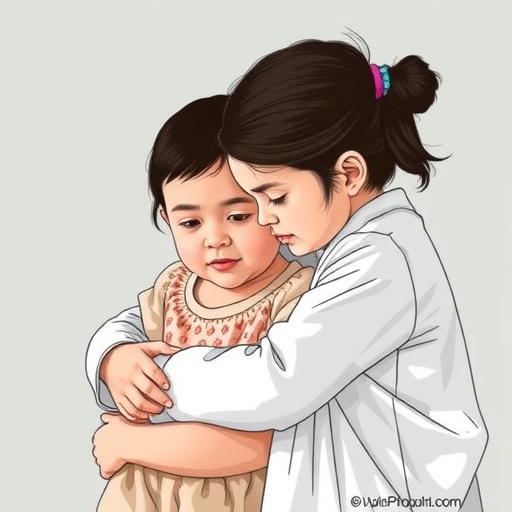In recent years, the complex dynamics of parent-child relationships have garnered increased attention from researchers across various psychological disciplines. However, a lesser-known aspect of this interaction is the phenomenon of Child to Parent Violence (CPV), a troubling inversion of expected familial roles. This issue, prevalent across different cultures and societies, highlights an urgent need for awareness and intervention. In a groundbreaking study conducted in Iran, researchers Khalvati, Jafarzadeh, and Ostadhashemi have taken significant steps to understand and measure this critical issue through the cultural adaptation of the Child to Parent Violence Questionnaire (CPVQ).
The study represents a pivotal advance in the psychological evaluation of CPV in the Iranian population, drawing attention to the need for tailored assessment tools that account for cultural nuances. CPV is often understood as a pattern of violent behavior exhibited by children towards their parents, and its ramifications are both psychological and social. The emotional toll it bears on families, as well as its broader implications for community and societal health, cannot be overstated. Family systems are designed on the principle of reciprocal respect and care, yet incidents of violence can destabilize these fundamental dynamics.
To address the cultural context of CPV, the authors undertook a meticulous process to adapt the existing Child to Parent Violence Questionnaire, ensuring that the language, content, and scenarios were relevant to Iranian cultural norms. This involved extensive consultations with local experts in psychology, sociology, and cultural studies, ensuring that the finalized questionnaire resonates with the realities faced by families in the region. Such rigorous adaptation practices can substantially enhance the validity of the research findings, making them more applicable across different settings.
Throughout their methodological rigor, the authors employed qualitative interviews alongside quantitative assessments, creating a comprehensive understanding of the factors that contribute to CPV. This multi-faceted approach enabled them to capture not just the prevalence of CPV behaviors but also the underlying causes that may trigger such violence. Social norms around parenting, expectations of filial obedience, and evolving family dynamics in modern Iranian society were integral aspects of their exploration.
Another critical aspect highlighted by the study is the prevalence rates of CPV in Iran. The researchers found that various socio-economic factors, including educational background, family structure, and socio-cultural pressures, correlated significantly with reported incidents of CPV. Families in lower socio-economic brackets reportedly experienced higher levels of conflict, which can lead to escalations in violence. These findings echo those from other parts of the world, suggesting a universal challenge that transcends cultural boundaries.
The study hypothesized that the normalization of media portrayals of violence and aggression might play a vital role in children’s behavior towards their parents. By exposing children to aggressive content through various media channels, societal attitudes towards conflict resolution can become distorted, leading to a permissive environment for violent behavior. Understanding these media influences on parental relations is crucial for the development of effective preventive strategies.
Moreover, identification of CPV extends beyond individual cases; it ties deeply into societal and systemic issues, including mental health awareness and resources for families. The stigma around acknowledging violence within familial relationships often leads to silence and isolation for affected parents, emphasizing the need for community-based interventions. The study points toward a growing recognition of the importance of providing educational resources and support networks for families dealing with CPV.
As the study garnered attention within national and international circles, it sparked discussions on the necessity of preventive measures and intervention programs specialized in addressing CPV. With the adapted CPVQ at their disposal, practitioners and clinicians in Iran can now better assess families at risk and identify appropriate therapeutic measures to alleviate the cycle of violence within homes.
The implications of this research extend well beyond academic interest; it illuminates a path forward for policymakers and community leaders interested in fostering healthier family relationships through prevention and early intervention strategies. Open dialogues about CPV can gradually dismantle the shame and stigma surrounding this often-taboo topic, empowering families to seek help without fear of retribution or judgment.
Furthermore, the cultural adaptation of the CPVQ not only enriches Iranian psychological research but also augments the global discourse surrounding CPV. As more cross-cultural studies emerge, there’s potential for developing a collective understanding of how cultural contexts shape family dynamics and inform behavioral expectations across generations. This could foster collaboration across borders, thereby enriching research methodologies and shared resources.
In conclusion, the pioneering work by Khalvati, Jafarzadeh, and Ostadhashemi represents a significant step towards understanding CPV in the Iranian cultural context. Their findings illuminate the pressing need for awareness surrounding CPV, as well as the importance of culturally competent tools for assessment and intervention. With continued research and dialogue, there is hope for effectively addressing the underlying causes of CPV, ultimately leading to healthier familial relationships and enhanced well-being for children and parents alike.
As discussions about child-parent violence continue to unfold, the contributions of this research will likely serve as a cornerstone for further inquiries and interventions aimed at fostering healthier family dynamics, thereby creating a more supportive environment for future generations.
Subject of Research: Child to Parent Violence in Iranian Population
Article Title: Cultural adaptation and prevalence of the Child to Parent Violence Questionnaire Parents Version in the Iranian population.
Article References:
Khalvati, M., Jafarzadeh, D., Ostadhashemi, L. et al. Cultural adaptation and prevalence of the Child to Parent Violence Questionnaire Parents Version in the Iranian population.
Discov Psychol 5, 102 (2025). https://doi.org/10.1007/s44202-025-00441-5
Image Credits: AI Generated
DOI:
Keywords: Child to Parent Violence, Cultural Adaptation, Psychological Research, Family Dynamics, Iranian Society.




